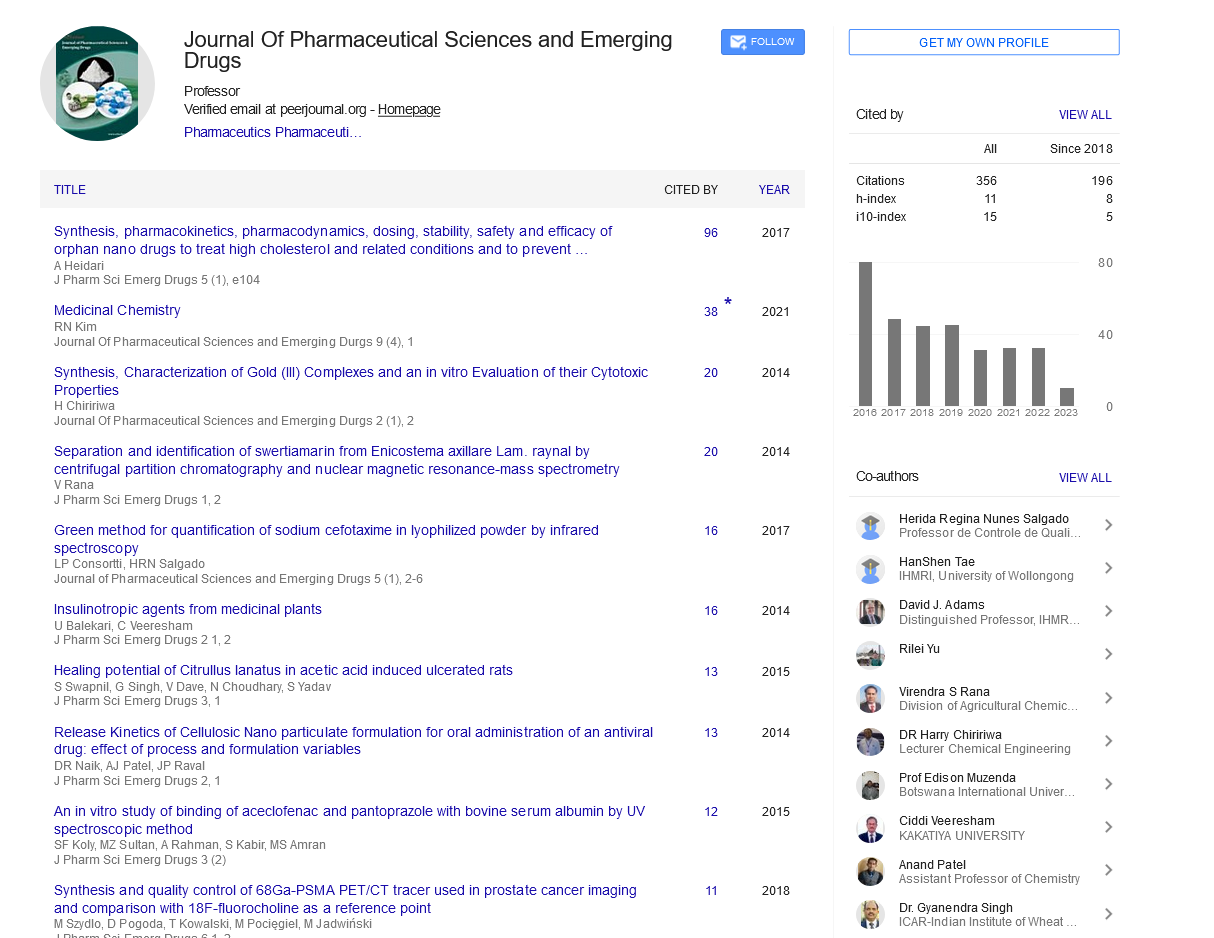Commentary, J Pharm Sci Emerg Drugs Vol: 12 Issue: 4
Repurposing Approved Drugs for Novel Therapeutic Uses
Sophie Gilbert*
1Department of Pharmacology, University of Manitoba College of Medicine, Winnipeg, MB R3T 2N2, Canada
*Corresponding Author: Sophie Gilbert,
Department of Pharmacology, University
of Manitoba College of Medicine, Winnipeg, MB R3T 2N2, Canada
E-mail: sogilbert@yahoo.com
Received date: 21 July, 2024, Manuscript No. JPSED-24-148313;
Editor assigned date: 23 July, 2024, PreQC No. JPSED -24-148313 (PQ);
Reviewed date: 06 August, 2024, QC No. JPSED -24-148313;
Revised date: 13 August, 2024, Manuscript No. JPSED-24-148313 (R);
Published date: 20 August, 2024, DOI: 10.4172/2380-9477.1000200.
Citation: Gilbert S (2024) Repurposing Approved Drugs for Novel Therapeutic Uses. J Pharm Sci Emerg Drugs 12:4.
Description
Drug repurposing, also known as drug repositioning, refers to the process of identifying new therapeutic uses for existing, approved drugs. This approach has gained increasing attention in recent years, as it offers a promising pathway to accelerate drug development while reducing the cost and risks associated with bringing new drugs to market. Repurposing allows researchers to known safety profiles, pharmacokinetics and manufacturing processes of existing drugs, making it an attractive alternative to traditional drug discovery methods. The traditional process of drug development is timeconsuming, expensive and fraught with failure. It typically takes over a decade and billions of dollars to bring a new drug from the discovery phase to market, with a significant portion of candidates failing in clinical trials due to unforeseen safety or efficacy issues
Repurposing existing drugs circumvents many of these hurdles by utilizing compounds that have already been tested and approved for human use. Since the safety and pharmacological profiles of these drugs are well-established, the focus can shift primarily to evaluating their efficacy in new indications, thus shortening the development timeline and lowering costs. Furthermore, repurposing provides an opportunity to address unmet medical needs, particularly for rare diseases, neglected diseases, or conditions where existing treatments are insufficient. Many diseases lack effective therapies and in some cases, drug repurposing may offer a faster solution than discovering entirely new compounds. Additionally, with the rise of precision medicine and the growing understanding of disease mechanisms, researchers are increasingly able to identify off-target effects of drugs that can be beneficial for conditions other than those for which they were originally developed.
Several successful examples of drug repurposing have demonstrated the potential of this strategy. One of the most wellknown cases is the repurposing of thalidomide, a drug that was initially developed as a sedative and used to treat morning sickness in pregnant women in the late 1950s. Thalidomide was withdrawn from the market due to its teratogenic effects, which led to severe birth defects. Decades later, however, it was found to be effective in treating multiple myeloma, a type of cancer, as well as certain inflammatory conditions like leprosy. Another notable success is sildenafil, originally developed to treat hypertension and angina (chest pain). During clinical trials, it was observed that the drug had a significant side effect: It enhanced erectile function.
As a result, sildenafil was repurposed and marketed as Viagra, one of the most widely used treatments for erectile dysfunction. More recently, it has been investigated for other conditions, such as pulmonary arterial hypertension. Despite the advantages, drug repurposing is not without challenges. The primary issue is that a drug’s safety profile for one condition does not necessarily guarantee its safety or efficacy for another. Differences in dosage, duration of treatment, and patient populations can lead to unexpected side effects or reduced efficacy. Moreover, intellectual property and regulatory hurdles can complicate the process. Many repurposed drugs are offpatent, which may disincentive pharmaceutical companies from investing in large-scale clinical trials required for approval in new indications.
Repurposing approved drugs for novel therapeutic uses holds tremendous potential to address unmet medical needs and accelerate the drug development process. While there are challenges, particularly in terms of clinical validation and regulatory approval, the successes to date demonstrate the value of this approach. As scientific understanding of disease biology continues to evolve and new technologies such as artificial intelligence are applied to drug discovery, drug repurposing is likely to remain a key strategy in modern therapeutics, offering hope for more rapid and cost-effective solutions to a wide range of health challenges.
 Spanish
Spanish  Chinese
Chinese  Russian
Russian  German
German  French
French  Japanese
Japanese  Portuguese
Portuguese  Hindi
Hindi 